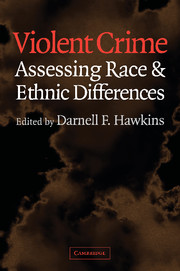Book contents
- Frontmatter
- Contents
- Contributors
- Foreword
- Editor's Introduction
- Violent Crime
- Part I Homicide Studies
- Part II Other Contexts, Settings, and Forms of Violence
- Part III Explaining Racial and Ethnic Differences
- 11 How Can the Relationship between Race and Violence be Explained?
- 12 “Race Effects” and Conceptual Ambiguity in Violence Research: Bringing Inequality Back In
- 13 The Violent Black Male: Conceptions of Race in Criminological Theories
- 14 The Structural-Cultural Perspective: A Theory of Black Male Violence
- 15 A Cultural Psychology Framework for the Study of African-American Morality and Violence
- 16 Racial Discrimination and Violence: A Longitudinal Perspective
- 17 Honor, Class, and White Southern Violence: A Historical Perspective
- References
- Index
15 - A Cultural Psychology Framework for the Study of African-American Morality and Violence
Published online by Cambridge University Press: 22 August 2009
- Frontmatter
- Contents
- Contributors
- Foreword
- Editor's Introduction
- Violent Crime
- Part I Homicide Studies
- Part II Other Contexts, Settings, and Forms of Violence
- Part III Explaining Racial and Ethnic Differences
- 11 How Can the Relationship between Race and Violence be Explained?
- 12 “Race Effects” and Conceptual Ambiguity in Violence Research: Bringing Inequality Back In
- 13 The Violent Black Male: Conceptions of Race in Criminological Theories
- 14 The Structural-Cultural Perspective: A Theory of Black Male Violence
- 15 A Cultural Psychology Framework for the Study of African-American Morality and Violence
- 16 Racial Discrimination and Violence: A Longitudinal Perspective
- 17 Honor, Class, and White Southern Violence: A Historical Perspective
- References
- Index
Summary
Despite an overall decline in youth violence, urban African-American children and adolescents continue to be disproportionately represented among both perpetrators and victims of violence (e.g., Snyder and Sickmund, 1999). Although African Americans comprise a mere 15 percent of the U.S. youth population, they account for over half the arrests for homicide nationwide (Snyder and Sickmund, 1999). Incidents of nonfatal assaults are also higher among African-American youth compared to youth of other ethnic backgrounds (e.g., Sanders-Phillips, 1997). The rate of suicide for African-American males has doubled since 1980 (Snyder and Sickmund, 1999), and sizable numbers of African-American youth have participated in the violent activities associated with many of the major urban rebellions (Gale, 1996; Harris, 1998; Bush, 1999).
The trend toward same-race assaultive violence has made homicide a leading cause of death among African-American adolescents (Coie and Dodge, 1998; Snyder and Sickmund, 1999). In addition, African-American children and youth experience high rates of nonlethal injury (Sanders-Phillips, 1997), and frequently witness acts of violence against others, including murders (e.g., Shakoor and Chalmers, 1991; Jenkins and Bell, 1997). These children and youth are also increasingly exposed to hate crimes, police brutality, and more subtle forms of structural violence such as substandard housing, poor education, and high unemployment (Sparks, 1994). The prevalence of violence in the lives of African-American youth, especially young men, is so great that the notion of genocide has been offered to accurately describe their life circumstances (Johnson and Leighton, 1995).
- Type
- Chapter
- Information
- Violent CrimeAssessing Race and Ethnic Differences, pp. 303 - 318Publisher: Cambridge University PressPrint publication year: 2003

